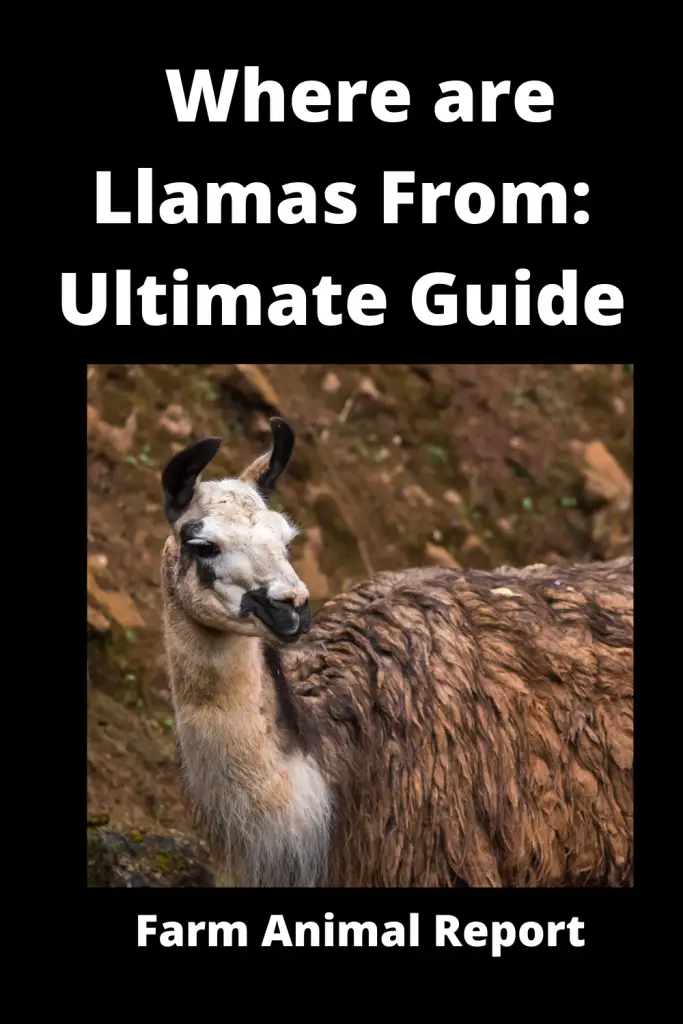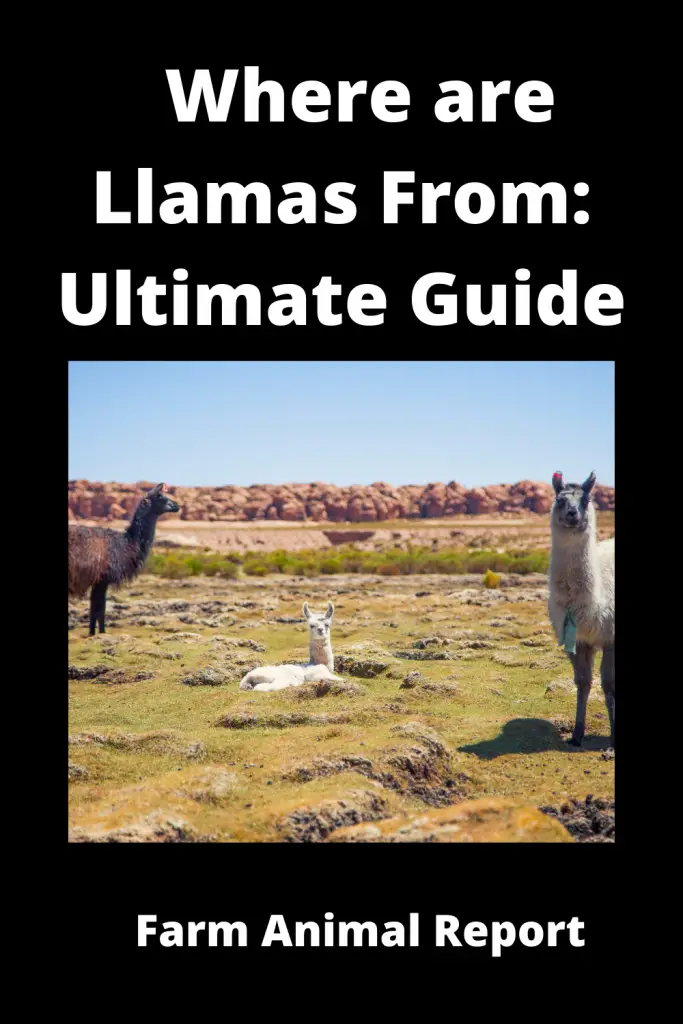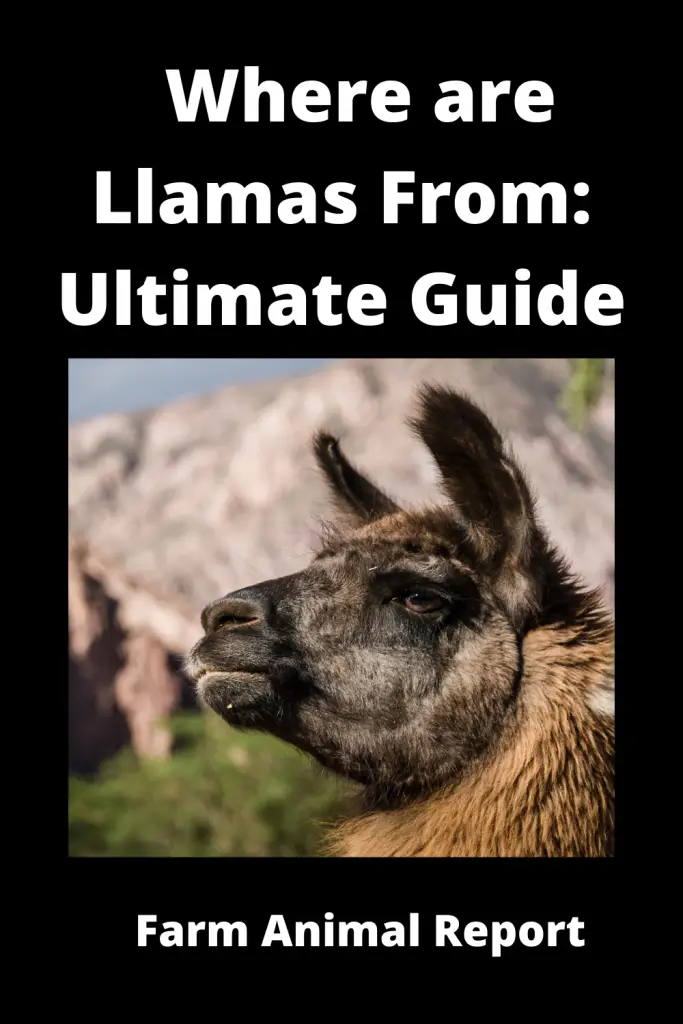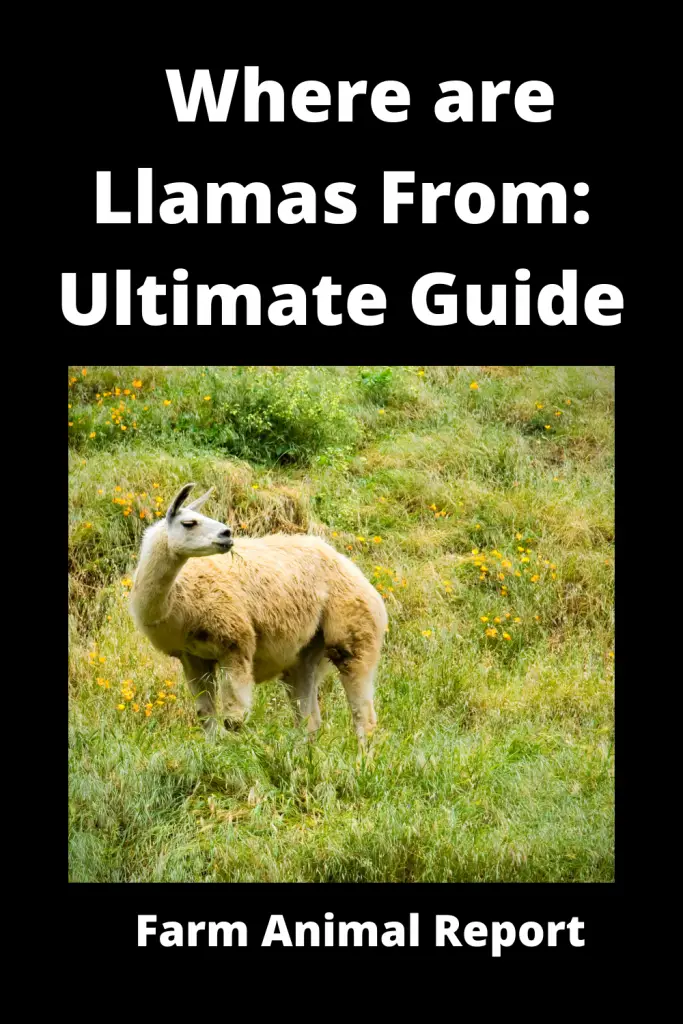As a general rule Lamas are originated from the Andes region of South America, although their current range extends far beyond that region of the continent. Llamas can be found worldwide — in Australia, Europe, and North America, to name a few locations. These herbivorous pack animals are not uncommon in the South American continent, where they may be found in Peru, Ecuador, Argentina, Bolivia, and Chile, among others.
Where are Llamas From
Where are Llamas From – The llama is a South American mammal similar to camels in appearance and temperament. Llamas have thick and long hair that shows a range of multiple hues such as white, brown, black, red, and even speckled. It is uncommon for llamas to be found in natural habitats, so they are kept in captivity worldwide for mercantile purposes.
See What Amazons Educational Resources for Raising LLamas
What Country are Llamas From?
Where are Llamas From – Lamas are originated from the Andes region of South America, although their current range extends far beyond that region of the continent. Llamas can be found worldwide — in Australia, Europe, and North America, to name a few locations. These herbivorous pack animals are not uncommon in the South American continent, where they may be found in Peru, Ecuador, Argentina, Bolivia, and Chile, among others. They are particularly common in Peru, where they have a large population.

The Llama’s Natural Habitat
Llamas are native to the rugged mountainous terrain of western South America’s severe mountainous areas, notably plateaus and mountains that rise above 10,000 feet in height. Llamas are adapted to a grassy and open setting, which is their natural habitat. In these high altitudes, the air is incredibly thin, and llamas are fortunate in that they have specialized blood capable of dealing with landscapes with little oxygen available to them. Llama blood includes exceptionally high concentrations of hemoglobin, which allows it to maintain oxygen levels at a high level with excellent efficiency.
18 ways Alpaca Farmers make Money
Llamas Living on Farm
Llamas are no longer seen in the wild, but they can be found on farms and ranches worldwide, including in the United States. The employment of llamas to guard farm animals — such as sheep and cattle — from the clutches of deadly predators is expected in the western region of the United States, for example.
Where are Alpacas from Initially?
Alpacas are native to the Altiplano (Spanish for “high plain”) in west-central South America, where they were domesticated. This region of the Andes, which straddles the borders of Peru, Chile, and Bolivia, has an average elevation of about 4000 meters above sea level.
Can Llamas be Found in the Wild? Or Are there Wild Llamas?
No, they can not be found in the wild, or there are no wild llamas. The llama and the alpaca are domesticated animals. The only wild species from the camelid family is the Guanaco.
What is the Difference between Alpaca and Llama?
The alpaca is a close relative of the llama. Alpacas are an excellent choice for homesteaders because of the more luscious fleece they produce when clipped. The alpaca’s fleece is exceptionally soft and is much sought after by spinners. Llamas and alpacas are similar in that they are easy to care for and will guard property and other animals in much the same way as they do with llamas.
Some animals and humans, on the other hand, find them to be significantly less terrifying. Compared to llamas, they are a little smaller and have more kind eyes that do not inspire the same amount of dread in the viewer. However, they do a decent job with tiny predators such as coyotes, hawks, possums, skunks, and weasels, among others.
Aside from their size, the most noticeable morphological distinctions between alpacas and llamas are their hair texture and the form of their faces. Additionally, their dispositions differ, which impacts the way people have interacted with them throughout history.
They are also significantly different in size, which is another distinguishing feature between the two creatures. They are smaller, standing roughly 90 cm (35 inches) tall at the shoulder and weighing between 55 and 65 kilograms (121 to 143 pounds). Llamas are the largest lamoid species, measuring approximately 118 cm (46 inches) at the shoulder and weighing about 110 kg (248 pounds).
As a result, llamas will be far more significant than their cousins. Llamas and alpacas have quite different facial features: alpacas have small, blunt cheeks with short ears, while llamas have elongated faces with ears the size of bananas.
Another significant difference is the color of their hair. Alpacas have shaggy hair that is used in the creation of alpaca fleece. Their hair color can range from whites and light yellows to browns and blacks, depending on the species. Llamas have rougher hair, and their wool is regarded inferior, but llama breeders strive to develop a llama breed with more delicate, softer hair to compete with other domesticated animals.

Llamas are commonly used as pack animals by humans due to their ability to carry significant weight. Llamas can carry up to 45 to 60 kg (99 to 132 pounds) of weight for distances of up to 29-30 km (18-19 miles) each day.
On the other hand, Llamas have a negative reputation because they react by kicking, spitting, lying down, or refusing to move when they are overworked or mistreated. Generally speaking; however, they are kind and gentle creatures. On the other hand, Alpacas are a little more reserved and prefer to remain with their group of friends. Sheep and alpacas can be protected by llamas, which can also serve as security animals.
When did Llamas become Domesticated?
Llamas are believed to be descended from guanacos, their wild cousins, and were domesticated for the first time around 4,500 years ago.
Who was the First to Domesticate Llamas?
The people of Peru and Ecuador were the first to domesticate llamas. They domesticated in the Peruvian Andes about 6000–7000 years ago, and by 3,800 years ago, they had been transferred to lower elevations. By 1,400 years ago, they were being kept in herds on the northern beaches of Peru and Ecuador.
Who Domesticated the Alpaca?
The Andes domesticated them for the first time. Alpacas are descended from camelids in North America and traveled to South America 3 million years ago. These animals first appeared approximately 6,000 years ago.
How did the Incas use Llamas?
Llamas were the Incas’ most significant domestic animal, supplying them with food, clothing, and the ability to act as animals of burden, among other things.
Who were the Incas, and what was their History?
Incas were people who lived in the 15th century. At its height in the 1400s, the Inca Empire covered more than 5,500 square kilometers and was the most significant state on Earth. Inca aristocrats commanded an empire of 12 million conquered people spread across the Andes mountain range in South America, with around 40,000. The Incas transformed mountainsides into lush, terraced farms by diverting rivers and employing sophisticated irrigation systems.
Subjects were obligated to furnish soldiers and laborers to work on farms and in mines, among other things. Spanish armies first landed in the Andes in the 1530s and eventually defeated the Incas after a 40-year battle in the mountains.
Llamas are most intimately linked with the Incas, who used them as beasts of burden and sacrificed hundreds of them to their gods every year. Llamas are also associated with the Aztecs and the Mayans. For example, Capac Raymi (January) was a month in which they sacrificed 100 camelids with “length wool and rigid straight tails.” Following that, in the month of Camay (February), they slaughtered 100 camelids that were “light brown” in color with “white from the knees down and whiteheads.”
While it would have been thought that such a vast number of sacrifices would have had a negative impact on llama populations, careful management ensured that the flocks survived and prospered. The Incas avoided slaughtering female llamas to ensure that sufficient numbers of animals were available for breeding.
They also devised an innovative way of treating a disease known as “carache” (which was most likely scabies), burying diseased animals “at once, deep in the ground” to prevent them from contaminating the rest of the flock. Every November, they also conducted a census of camelids to quantify their population, writing the results on quipus, which were knotted threads used as accounting at the time.
Where did Llamas Initially come From? Or Where are Llamas Native to?
Llamas’ ancestors originated on the Great Plains of North America around 40-50 million years ago. They migrated to South America three million years ago, when a land bridge connected the two continents, allowing them to survive in both environments. According to legend, they are thought to be descended from guanacos, its wild cousins, and were initially tamed approximately 4,500 BC.
South American camelids, the only livestock domesticated by humans anywhere in the New World, played a role in the Andes that was comparable to that of horses, cattle, and sheep in Europe, providing ancient Peruvian civilizations with transportation clothing, and sustenance. They played an essential role in the cultures of the Nazca.
Where did llamas and Alpacas Originate?
Alpacas are native to South America (as discussed above) and are descended from the wild Vicuna, which is now considered a threatened and endangered species. At the same time, the llama is descended from the wild Guanaco, which is still reasonably abundant throughout the continent.
Which came first, Alpaca or Llama?
Archaeological evidence suggests that alpaca came first because they travel to lower elevations about 3,800 years ago and are in evidence to be seen by coastal locales about 900–1000 years ago. While llamas and alpacas were domesticated in the Puna highlands of central Peru around 6,000–7,000 years ago, alpacas were the first to be tamed.
What are the Benefits of Owning a Llama?
Aside from providing companionship, meat, and fiber production, owning a pet llama or alpaca offers the option to train and display them, and they can also protect a guard animal.
When contemplating whether to adopt a llama or an alpaca, prospective owners should keep in mind the extensive care these animals require, including immunizations and routine dental care, as they are prone to tooth abscesses and need trimming their enlarged incisors.
These beautiful creatures provide a wide range of advantages to persons attempting to live a self-sufficient existence. Llamas can produce vast amounts of wool for spinning, matting for blanket and pillow fill, and even insulation from a single animal. They are easy to breed and can be used for both meat and milk production.
If you enjoy hiking for pleasure or if you need to transport things about the property, llamas are excellent beasts of burden capable of carrying a significant amount of weight. The best part is that even a single llama may be a firm guardian for your other livestock as well as your land! It is possible to teach llamas to drive, and they make great cart animals because they require less care than horses kept for the same purpose.

Despite their enormous size, llamas are relatively simple animals to care for. If you have a small portion of land, you will most likely be able to accommodate one or two llamas with relative ease. In the case of keeping one llama only for guardian and wool production and as a companion for other herd-oriented livestock, gelding is preferred. A gelding is a castrated male horse who will be less challenging to deal with than an intact male or female horse of the same gender
Llamas for Protection
In addition to chickens and ducks, you may have other livestock such as sheep, goats, horses, or even cows, all of which are prone to predation. Even little coyotes can pose a serious threat to small livestock, and a pack of coyotes can quickly bring down a herd of horses or cows.
Llamas are becoming increasingly popular as guardian animals because they require less care and training than dogs and are less likely to leap a fence and walk around freely than canines. The best part is that a single llama can protect several hundred other animals, yet they are equally comfortable with just one or two charges to watch over.
Integrating a llama into an existing herd of sheep or goats can be accomplished fast and easily with a small number of temporary fences. Place the new llama in an enclosure next to the existing llamas so that they can see, hear, and smell each other. This adjustment phase can last anywhere from a single day to as long as a week.
Removing the separating fencing will allow the llama and its livestock charges to become more comfortable with one another. They will be able to share pasture and shed spaces at this point. Always verify that new animals have been isolated for a sufficient amount of time to guarantee that they are healthy and fit before introducing them to one another.
Llama Care
Llamas are as simple to feed as other grazing animals, yet they consume less grain than other grazing animals. Llamas are excellent grazers if there is sufficient pasture available. Grassed hay can be used as a substitute for pasture in colder locations where pasture is not accessible during the winter months.
Llamas consume a relatively small amount of food given their enormous size. An adult llama can survive on one or two flakes of hay each day, as well as a small amount of grazing land. To achieve the optimum grazing outcomes, divide your pasture into multiple small regions and rotate your grazing animals across them so that each animal has time to heal and thrive.
The size of each grazing lot will be determined by the number of animals grazing on it. Water should be given to llamas at all times, just as it should be for other animals.
Llamas are, on the whole, highly hardy animals. They are less susceptible to illness than most cattle, but they will still require routine veterinary treatment. Cleaning and trimming your llama’s feet can help to maintain him looking his best and prevent him from being lame in the future. They should also receive tetanus vaccinations and vitamin C and D supplements to help lower the risk of developing enterotoxaemia in the future. Depending on where you live, your vet-doc may recommend additional immunizations to maintain your animals in excellent health. Ask your veterinarian for recommendations.

Housing for Llamas
Llamas do not require the use of a barn or other formal structure to be housed. Llamas are pretty comfortable in all types of weather because of their rich wool. These animals can survive in even the worst climates, and the thick wool protects them from the heat and sun. Because drafts are more detrimental than temperature fluctuations, llamas should be given the same type of shelter that sheep are offered in the pasture. A windbreak will suffice, and a run-in type of shed that allows them to get out of the rain or blow winds will be much more beneficial to them.
Human Predators Must Be Watched Out For
We frequently consider the natural predators that animals have and then take precautions to protect ourselves from coyotes and other wildlife. A llama, on the other hand, will give enough security from intruders as well. They will become acquainted with “their” people and prove to be a solid adversary to anyone who does not belong on the land. Make no doubt about it: a llama is a powerful source of discouragement.
Dogs are popular as property guardians, but they can also cause legal issues for their owners if they are not adequately trained. You may be held liable for any injury that your dog causes, regardless of whether you did something wrong. Llamas perform their duties without inflicting physical harm on the invader on the vast majority of occasions. Their size, as well as their proclivity to spit at and chase visitors, serves as a non-violent deterrence to would-be intruders.
Other uses
A llama’s wool should be sheared at least once a year to preserve it in the most satisfactory possible condition. The produce from the clipping can be used in a variety of ways. It can even be sold or bartered to other homesteaders in exchange for commodities, services, or financial compensation. If you decide to have a llama to guard your property or other purposes and do not have any other livestock, keep in mind that llamas are considered herd animals/camelids and require at least one other company llama or another animal to be happy and healthy.
Can you Make Money with Llamas?
Yes, llama farming is a very profitable enterprise. Farmers who raise llamas for meat, fleece, and milk can profit by selling the animals or breeding them for other purposes.
What are llamas and Alpacas used for?
Llamas and alpacas have been domesticated and used for transportation, meat production, and fleece production. Both species are found predominantly in Peru and Bolivia, and they are members of the Camelidae family, as discussed above.
Why do Farmers have Llamas?
Farmers usually have llamas for protection and transport. A guard llama is best for protection.
The term “guard llama” refers to any of the following species of llama: Guanaco, alpaca, or hybrid. They are used in farming to protect sheep, goats, chickens, or other livestock from coyotes, dogs, foxes, and other wild animals.
Where do Llamas live in the Wild?
Llamas are domesticated animals that do not live in the wild.
What is a Wild Llama Called?
There are no wild llamas; hence they do not have any particular name. But their ancestors are considered wild.
The Guanaco (Lama guanicoe) is a wild camelid native to South America closely related to the llama and considered its ancestor.
Learn More – 18 Ways Farmers Make Money Raising Alpacas
Fun Facts about Llamas
- Llamas are well aware of their own limitations. It is conceivable that a llama will lie down or simply refuse to move if you attempt to overload it with too much weight.
- It has been approximately 6,000 years since llama fleece has been shorn and utilized in textiles in the Peruvian Andes Mountains. Llama wool is lightweight, warm, and water-resistant, and it contains no lanolin.
- In difficult locations, llamas are resilient and well-suited for survival. They have excellent footing and are capable of crossing rugged terrain at high altitudes.
- Llamas are intelligent and simple to train.
- For more than three decades, llamas have been utilized to protect livestock such as sheep or even alpacas in North America, mainly since the 1980s. To be a successful guard, they require little or no formal training.
- Llamas are not aggressive animals. It is only when they are irritated that they spit, primarily directed towards one another. When irritated, llamas will also kick and neck wrestle with one another.
- Llamas are vegetarians, and their digestive processes are highly efficient.
Final Thoughts
Llamas are well-known as eccentric, long-necked animals that are known for spitting and humming periodically. They’re frequently confused with alpacas, who are close relatives of the llama. Both are members of the camelid family, which also includes camels, guanacos, and vicunas, among others. Llamas (scientifically known as Lama glama) were initially introduced to the United States in the late 19th century, where they were displayed as oddities in zoos until the early 1900s. In the United States and Canada, there are currently more than 170,000 llamas.


